Abstract
In our modern world, many Internet of Things (IoT) technologies are being researched and developed. IoT devices are currently being used in many fields. IoT devices use Wi-Fi and Bluetooth, however, communication distance is short and battery consumption is high. In areas such as smart cities and smart farms, IoT technology is needed to support a wide coverage with low power consumption. Low Power Wide Area (LPWA), which is a transmission used in IoT supporting a wide area with low power consumption, has evolved. LPWA includes Long Range (LoRa), Narrowband (NB-IoT), and Sigfox. LoRa offers many benefits as it communicates the longest distances, is cheap and consumes less battery. LoRa is used in many countries and covers a range of hundreds of square kilometers (km2) with a single gateway. However, if there are many obstacles to smart cities and smart farms, it causes communication problems. This paper proposes two (2) solutions to this problem: the relay method which is a multi-hop method and the Automatic Repeat Request (ARQ) system that detects packet loss in real-time and requests retransmission for LoRa. In this study, the actual performance of LoRa in the problematic environment was measured and the proposed method was applied. It was confirmed that the transmission rate of LoRa dropped when there were many obstacles such as trees. To use LoRa in a smart farm with a lot of space, multi-hop was observed to be better. An ARQ system is needed to compensate for the unexpected drop in the forward rate due to the increase in IoT devices. This research focused on reliability, however, additional network methods and automatic repeat request (ARQ) systems considering battery time should be researched in symmetry. This study covers the interdisciplinary field of computer science and wireless low power communication engineering. We have analyzed the LoRa/LoRaWAN technology in an experimental approach, which has been somewhat less studied than cellular network or WiFi technology. In addition, we presented and improved the performance evaluation results in consideration of various local and climatic environments.
1. Introduction
In recent times, the Internet of Things (IoT), which is one of the technologies of the fourth Industrial Revolution, is rapidly changing the way humans create, exchange, and distribute value. IoT devices are now widely used in smart homes and cities, agriculture, healthcare, energy engagement, gas metering, fluorescent control, and pet trackers. In terms of the distribution of these devices, 2.6 billion devices were active worldwide in the year 2019 and 7.5 billion IoT devices are expected to be activated by the year 2025. IoT devices will also be mobile phones, which in the past were symbols of wealth, but would be carried by ordinary young children [].
Nowadays, IoT devices are characterized by small payloads of data and low power usage. Accordingly, various communication technologies for IoT devices such as Low Range (LoRa), Narrowband (NB-IoT), and Bluetooth Low Energy (BLE), which are Low Power Wide Area (LPWA) have evolved []. The advantage of LPWA is that it can communicate over long distances with low power consumption [].
LoRa is used in smart farms due to its low power consumption and wide coverage. LoRa infrastructure is inexpensive to build. In terms of communication coverage, it communicates the farthest. A single gateway or base station can cover several kilometers (Km) if such a gateway or base station installation is higher than an obstacle. However, for effectiveness, if there are many tall trees such as fruit farms, the gateway should be installed higher. As such, installation and maintenance costs can increase depending on the environment [].
Furthermore, LoRa uses the Industrial, Scientific and Medical (ISM) radio band. In the ISM band, regulation is being done through a duty cycle. For example, in the EU 868.0–868.6MHZ band, the maximum duty cycle is regulated to 1%. LoRa also defines and uses a spreading factor for communication range. The higher the spreading factor, the longer the communication distance, but the bitrate falls. Studies have revealed that most times, LoRa uses a high spreading factor for a wide range of communication []. However, as the spreading factor increases, the time that a packet stays in the wireless network increases in asymmetry, and as the number of nodes increases, the transmission rate for packets decreases. In addition, the EU uses the 868 ISM band, which overlaps with sigfox used in IoT. IoT devices using the ISM band will increase so that collisions between packets are more frequent and packet delivery rates are lowered [].
This paper covers the interdisciplinary field of computer science and wireless low power communication engineering. In this paper, the packet delivery rate of LoRa in a specific situation was confirmed through experiments and a retransmission scheme and network topology proposed for improving the reliability of LoRa. In Section 2, an overview of LoRa and LoRa’s network protocol technology, LoRaWAN, and the limitations of LoRa in smart cities and farms. In Section 3, describes the retransmission scheme and relay scheme. In Section 4, describes the LoRa testbed made through open-hardware, conduct experiments by applying the relevant techniques in the above-mentioned low transmission rate environment, and analyze and discuss the results.
2. Related Work
This section gives an overview of LoRa and LoRaWAN technology, and the limitations of LoRa in smart cities and smart farms.
2.1. Overview of LoRa and LoRaWan Network
Researches on the technology that can transmit and receive various information at low power in connection with IoT are continuously being carried out []. IoT devices are characterized by the exchange of information obtained using sensors. Since the information obtained through the sensors is not large, the data sent and received in IoT devices have a small payload in symmetry. In addition, unlike mobile communication and Wi-Fi, which are frequently used wireless communication with high bitrate and power consumption, IoT devices do not need high bitrates. It requires a network with low power that supports a wide range and minimizes unnecessary power consumption. This creates the concept of Low Power Wide Area Networks (LPWAN) used in IoT [].
LoRa is an LPWA technology that enables long-distance communication. It is used in many key parts of IoT that operate on less payload. Its advantages include good battery life, network capacity and wide range. Compared to other technologies, the LoRa device is cheaper. Not only are LoRa devices cheap, its gateways and base stations are also less expensive than other technologies. Furthermore, LoRa uses chip spread spectrum modulation schemes used in space and wartime situations that support a wide range while maintaining low power []. In addition, LoRa is open-hardware and open-source. It’s able to support an entire country with minimal infrastructure [].
LoRa uses low frequencies in different ISM bands that vary from country to country. The specification of LoRa is given in Table 1. In order to communicate over a wide range, the spreading factor must be raised []. However, as the spreading factor increases, the bitrate decreases. In the case of IoT devices that send and receive a lot of information, it is difficult to use a high spreading factor, notwithstanding, the sensor value of IoT devices can be sent with a bitrate as low as 290 bps.The time on air as depicted in Table 1 increases with an increase in the spreading factor and may lead to frequent packet collisions [].

Table 1.
Low Range (LoRa) specification (coding rate 4/5; bandwidth 125 khz; packet Error Rate 1%).
Aside from LoRa is LoRaWAN, an LPWAN using LoRa. LoRaWAN is composed of protocol and architecture including the network layer. It consists of ISM band, LoRa modulation, MAC protocol and application as shown in Figure 1. It uses the ISM band, which is an unlicensed frequency band and the frequency varies from country to country. Different bands are used in different regions, such as Europe (EU) 868–870 MHz and United States (US) 902–928 MHz. There is a fixed duty cycle for each frequency, and the frequency of the devices using the different ISM bands in each country must be followed [].

Figure 1.
LoRaWAN architecture [].
LoRa MAC is divided into three classes:A, B, and C. In the case of Class A, after receiving the uplink packet of end nodes, two (2) downlinks opens to receive the downlink packet. Class A is the most energy-efficient, however, it has the highest latency. Class B synchronizes nodes via a gateway beacon message. Class C on the other hand, always opens the downlink receive packet.
The network structure of LoRaWAN’s is shown in Figure 2. End nodes and gateways are connected in a single-hop fashion. It uses LoRa to communicate and does not support multi-hop. LoRaWAN pursues single-hop with no plans for the future support of multi-hop. End nodes using broadcast send information to all gateways. The advantage is that no handover is required, but there is a need to check for duplicate packets. In LoRaWAN, gateways are connected to network servers as a backhaul, such as 3G or ethernet, and network servers to application servers. All procedures here were secured with TCP/IP SSL [].
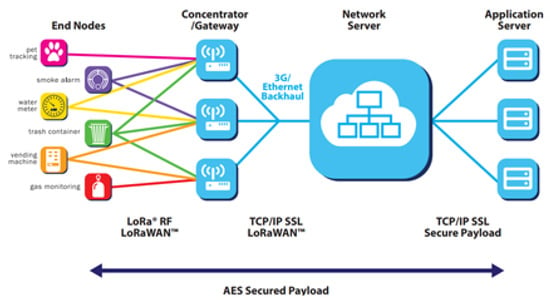
Figure 2.
LoRaWAN network architecture.
2.2. Limits of LoRa in Smart Farm and City
There are limitations to the use of LoRa in smart cities and farms. Most of the research related to LoRa networks is in the simulation stage. In actual experiments, LoRa’s extreme communication distance is measured and the distance is being updated. However, these experiments find and measure environments with minimal interference from the altitude and location of two communicating devices. Although there are LoRa network projects and technologies with real implementations presented such do not provide details about the actual environment. There are many studies on communication distances and future collisions, but few studies on problems in the real environment []. From these studies, it has been shown that the actual performance of LoRa falls with respect to smart farms. Data is coming out of open spaces and forests with many trees, but at the same distance but with a relatively low transmission rate [,].
There are a lot of practical cases of building a smart farm system using LoRa in Korea, but there are few cases in the case of wooded fruit trees as it is difficult to apply in practice [].
To solve this in a real environment, the locations of gateways and base stations are set high to allow for smooth data retrieval. However, higher locations increase installation costs as well as maintenance costs [].
Noteworthy, the use of LoRaWAN in smart farms may affect cloud services retrieval like AWS from Amazon.
3. Proposed Scheme
This section describes the automatic repeat request (ARQ) protocol and relay network to be applied to LoRa as well as the scenario where the proposed scheme is applied to a real-time IoT system.
3.1. Proposed ARQ Deployment in LoRa
The ARQ protocol applied in this paper leads to improved LoRa reliability with less overhead. LoRa is considered to be used in the IoT environment, which is a wireless sensor network (WSN). The WSN should consider two things. First is the minimal process. As it is an embedded device, by default, it should work smoothly. Second is its power consumption. A method that does not affect battery life should be used. Therefore, it is more efficient to send NCK only to the packet for the loss than to always check the loss by sending ACK to all packets.
3.1.1. Selective-Repeat ARQ Protocol
The operation process of the ARQ protocol to be applied to LoRa is shown in Figure 3. First, the device periodically sends data to the gateway. The gateway passes all the data sent by the devices to the network server. Here, the device and the gateway communicate wirelessly using LoRa while the gateway and server are connected as a backhaul. In this process, the device stores the packets that have been sent for a while in memory to retransmit lost packets. Packets that have been retransmitted or past a certain time are discarded. Selective repeat is used as a retransmission technique. Only lost packets request the NCK to minimize overhead. When a lost packet is found, the network server sends the NCK with the device’s information and the necessary packet information. The device recognizes lost packets through the NCK and retransmits them.
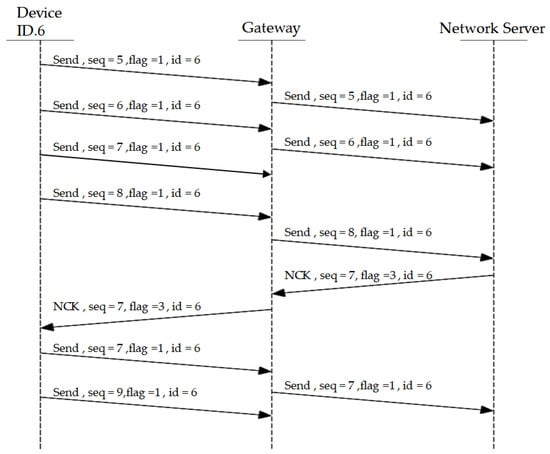
Figure 3.
Sequence diagram about packet loss.
In Figure 3, if packets 5 and 6 come in normally and packet 8 comes in before packet 7, packet 7 is detected as lost. If the packet from the device is lost, such as packet 7, the network server sends the NCK to the gateway with the device information and packet 7. The gateway checks the information of packet 7 to retransmit and forwards it to the device. Device 6 receiving NCK retransmits packet 7 and deletes it from memory.
The detailed operation of the network server is shown in Figure 4. All data forwarded from the gateway is managed in real-time and detected for errors. First, a check should be ensured to ascertain if the data is the information that is authenticated in the DB information. After that, if there is an error, it will request retransmission through the appropriate path. For the route, it uses the route determined by the RSSI value when the device was first turned on. It then receives the error packet again in the request message, but packets that fail more than once are dropped to minimize overhead. If an error occurs many times, it is difficult to solve due to large software overhead [].
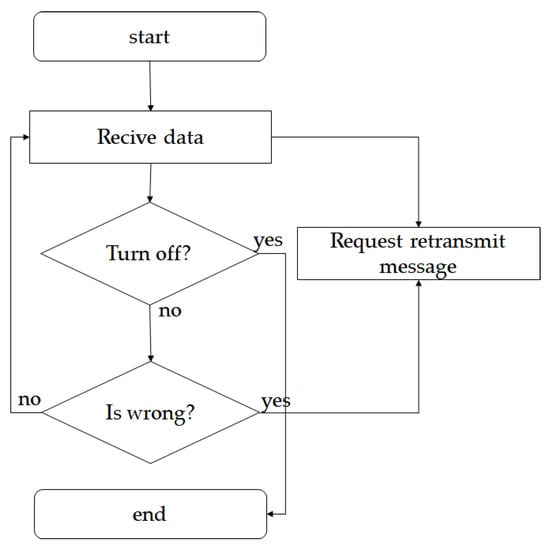
Figure 4.
Flowchart of network server operation process.
The operation procedure of the proposed technique for applying the ARQ protocol to LoRa is shown in Figure 5. First, the LoRa device for transmission is set up. Afterward, the process of receiving the sensor value and transmitting the data is repeated. During this process, checks should be ensured that there is no data to be forwarded around, other than time to send data periodically, no NCK to retransmit, and no message to stop the device. The ACK is not sent to minimize the overhead in consideration of loss and only sends NCK for the packet in error and requests retransmission. This is because the data has a small payload and low data-rate environment according to the characteristics of the WSN. Forwarding refers to the process of delivering the data or message to the correct address.
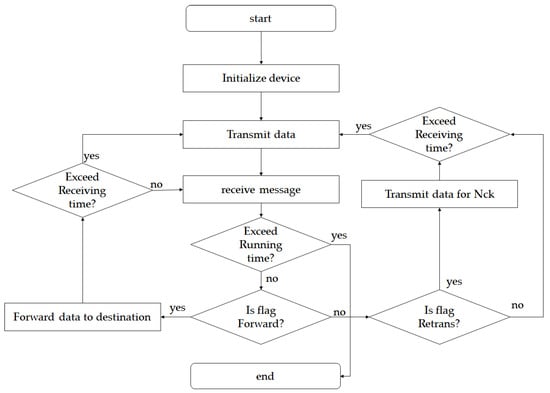
Figure 5.
Flowchart of LoRa device operation process.
3.1.2. Message Format for ARQ
The LoRa transport packet structure is shown in Figure 6. The header has a seq number and a flag indicating the type of id address packet. Payload basically has data to send and includes the header part that indicates the routing path according to the request message.

Figure 6.
Packet structure in the LoRa network.
The Flag value is shown in Figure 7. It is defined from 0 to 3 and each role has a different role. In the case of 0, it is a packet that informs the surrounding RSSI value. In case 1, it is a packet that transmits general sensor value. In case 2, it is a packet that informs forward, and in case 3, it is an NCK packet requesting retransmission. The flags used for ARQ are numbers 3 and 1. In case 3, when the end node receives it, it informs NCK and when the gateway receives it from the end node, it indicates the retransmitted packet.

Figure 7.
Flag content of the packet header.
3.2. Proposed Relay Node Operation in LoRa
In this paper, the relay method was used to solve spatial constraints as it relates to LoRa with a view to constructing a network with wider coverage. Nodes chose the best path by measuring the RSSI around them at first run. Nodes close to the gateway communicate directly. This connects all nodes so that they can communicate with the gateway. All data moves the way it was made. The gateway must be connected to the network server as a backhaul. All data sent by a node must be able to be sent to a network server, all messages requested by the network server must be able to be delivered to the nodes. The network server manages the data sent by the nodes and delivers them to the application. Network servers use the MQTT messaging protocol to manage data more efficiently for the IoT. The LoRa network architecture with a relay node is shown in Figure 8.
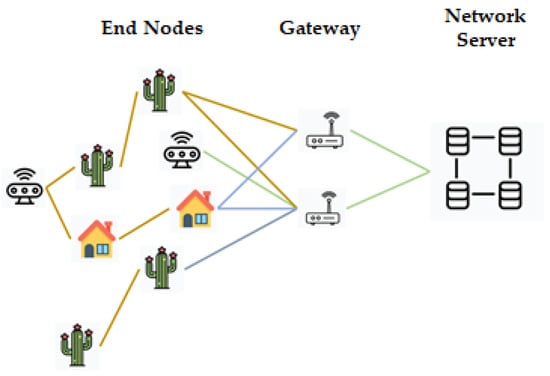
Figure 8.
LoRa network architecture with relay node.
4. Performance Evaluation and Analysis
This section describes the Open Hardware testbed used in the experiment.
4.1. Open Hardware Testbed
Prior to experimenting and discussing the LoRa protocol of the proposed method, the description of the implementation of LoRa testbed using open hardware such as Raspberry Pi and Arduino is presented. The testbed consists of LoRa Device, LoRa Gateway, and Network Server. LoRa testbed specifications are shown in Table 2.

Table 2.
LoRa testbed specification.
The testbed composition of LoRa is shown in Figure 9. The devices and gateways used Ardunio Uno and Dragino LoRa Shield, respectively, to run the Arduino sketch code for the open-source for the devices and gateways, respectively. The gateway has a structure for exchanging data with Arduino via USB serial communication. Afterward, a test was conducted to ensure the right delivery of the data from the device to the Raspberry Pi of the gateway. The frequency used was 868.1 MHz. After that, the gateway was able to check the payload value received by the device successfully.
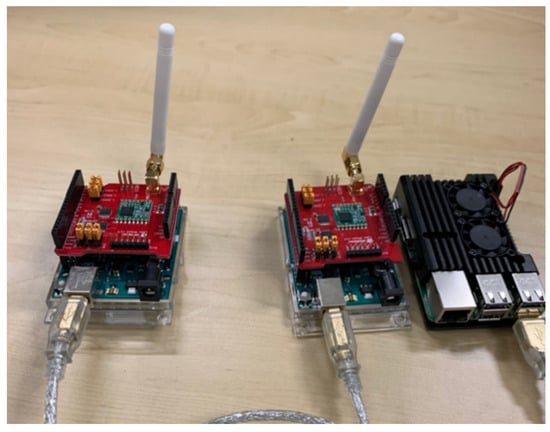
Figure 9.
The LoRa testbed.
Next, after constructing the testbed of the LoRa network proposed in this study, the data was successfully tested via the gateway.
As shown in Figure 10, the architecture was constructed by assuming the part that receives IoT information of the LoRa device and transmitting it to the gateway. Finally, the gateway was built to send data to the network server. The running Arduino sketch code using open source for the device and gateway followed. Packet transmission test was performed using the same spreading factor, bandwidth, frequency and coding rate as a testbed. As a result of packet transmission, it was confirmed that the gateway successfully received the packet. This is shown in Figure 11.
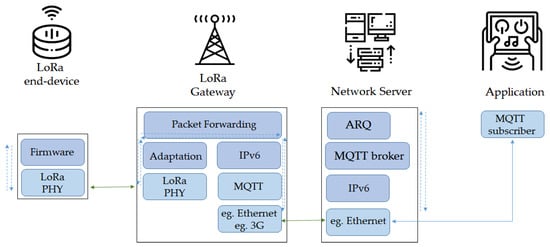
Figure 10.
LoRa Network Architecture.

Figure 11.
The result of LoRa packet transmission test.
4.2. Experiment Environment
Prior to the application of ARQ and Relay to the LoRa Network, an actual performance test was conducted. Experiments were conducted in a farm-like environment with minimal interference to determine the correlation between transmission rate according to distance and obstacles.
The location of the experiment was Icheon, Gyeonggi-do. It is a large plain with lots of ordinary rural houses with no tall buildings. Radio and mobile phones are also weak communication. A total of four (4) nodes were used. Three (3) were positioned to ascertain the relationship by distance, and the fourth was placed to understand the relationship with the obstacle. Information about the experiment site is shown in Figure 12. The blue dot depicts the location of the gateway and the yellow dots represent the nodes. In addition, some experimental and environmental settings as reported earlier and shown in Table 3 were employed.
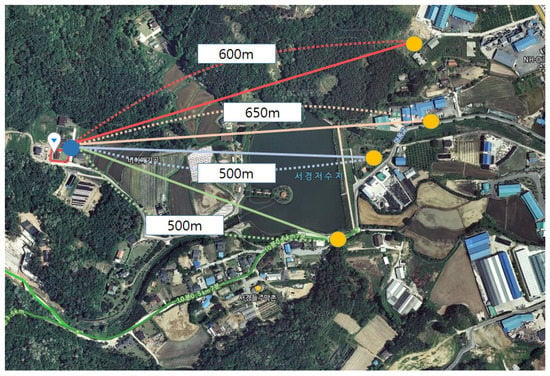
Figure 12.
LoRa Packet Delivery Ratio (PDR) experiment on scenario 1.

Table 3.
Experiment environment.
Lastly, this paper describes the experiments tested in the real environment using ARQ and Relay proposed in this paper. The experiment was conducted at Kyunghee University International Campus located in Yongin, Gyeonggi-do. As depicted in Figure 13, the blue dot is the location of the gateway and the highest point in the school, the observatory. The transmission rate was first tested by placing four (4) nodes between the main gate, which is 1 km red at the observatory. All devices were installed 1 m high outdoors with no obstacles. There were few obstacles between the observatory and the first red dot. Behind the first red are trees and buildings. Experimentation with ARQ and relay placing nodes on two (2) red dots followed.
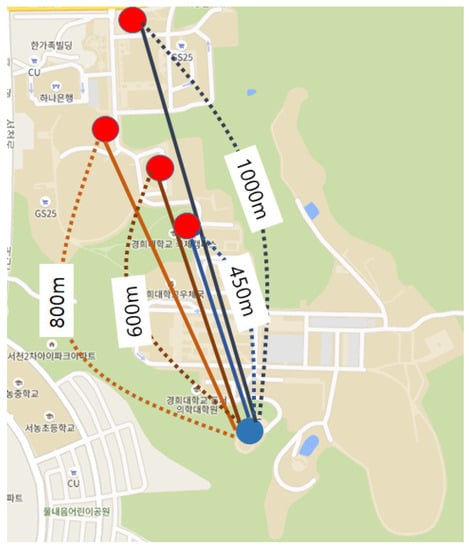
Figure 13.
LoRa PDR experiment on scenario 2.
4.3. LoRa PDR Evaluation Result and Analysis
The experiment conducted in Icheon-si is shown in Figure 14. The x-axis represents time in minutes and Y-axis the Packet delivery rates. The Packet delivery rate is the number of packets received by the gateway divided by the total number of packets sent by the node. End nodes are numbered 6–9. Nodes 6–8 show relationships according to distance, and 8 and 9 indicate the relationship according to the obstacle. Nodes 6 and 7, which have similar distances, have similar high transmission rates, show lower transmission rates than 8, which is 150 m away. Node 9 is closer than case 8 but at a similar rate.

Figure 14.
PDR on experiment scenario 1.
Furthermore, it can be seen that obstacles such as trees affect the transmission rate. Node 9, which is 150 m closer to the tree, has a lower propagation rate than node 8. Because of the high humidity change, there was a decrease in the rate of delivery depending on the weather and time, but the relative rate was always similar.
Figure 15 shows the experiment conducted at Kyung Hee University. The nodes were placed farther away from the gateway from 6 to 9. Similar to the previous experiment, it can be observed that the packet delivery rate decreases with distance. The difference with that of Icheon can be attributed to the many hills in Kyunghee University. Due to many floating populations, interference was high and as a result, lower packet delivery rates at similar distances from previous experiments could be observed. In addition, in the case of long distances and obstacles like that of the front door, the packet delivery rate was very low. This experiment also shows a similar trend in the graph after several trials.
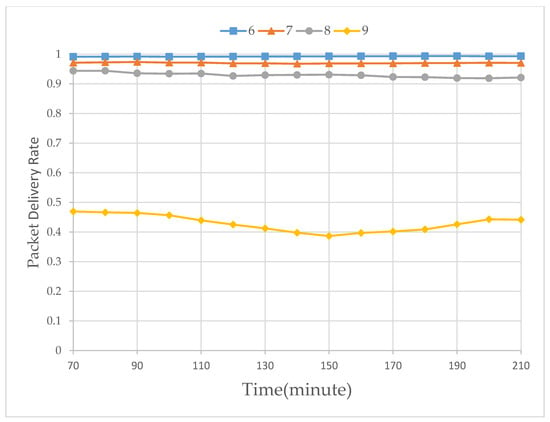
Figure 15.
PDR on experiment scenario 2.
4.4. ARQ and Relay Evaluation Result and Analysis
Figure 16 shows an example of applying a relay and ARQ with a gateway at the blue observatory, a node 450 m school gym (SunSeungGwan), and 1000 m front door (main gate). In previous experiments, the prep node showed a high delivery rate of over 99% and a 100% delivery rate. The node at the front door had a 94% pass rate. This is an increase of 58% from the previous 36%. The 36% packet delivery rate is very low, making it difficult to use in environments where data must be collected in real-time, such as on a smart farm.

Figure 16.
PDR with automatic repeat request (ARQ) and relay node on experiment scenario 3.
Figure 17 shows the transfer rate between nodes without ARQ and Relay. Although the experiments conducted at Kyung Hee University showed a much lower transmission rate than the previous experiments, experiments were conducted for each section in order to have reliable data. It is 99% between the observatory and SunSeungGwan and 89% between the main gate and SunSeungGwan. It can be observed that the communication between the main entrance and the crew building with a lot of buildings and trees in between shows a lower transmission rate. However, a comprehensive comparison shows up to 89% when relaying and 36% when communicating directly from the main gate to the observatory. When ARQ was applied, it shows a delivery rate of 94%, which is 5% higher.
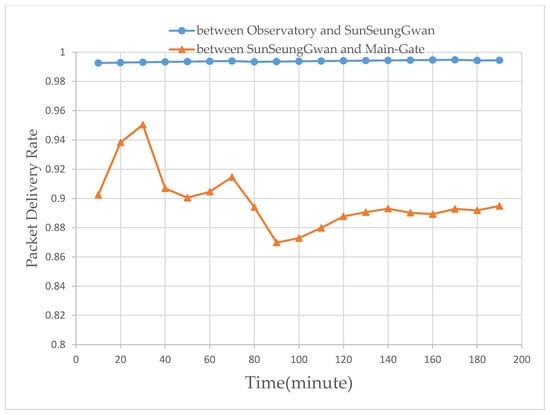
Figure 17.
PDR on experiment scenario 3.
Overall, what is commonly seen in the first and second places is that the transmission rate varies depending on the presence or absence of obstacles, even at the same distance. In addition, it was confirmed that the application of relay and ARQ can effectively form a wide network with a higher transmission rate.
5. Conclusions
In modern times, the use of IoT devices is on the increase. Just as mobile phones have become a device for everyone, the IoT market is expected to grow so that IoT devices can be made available for everyone. As the number of IoT devices increase, the use of radio waves will increase as well.
This paper proposes and implements a multi-hop relay and ARQ system for solving the challenges associated with LoRa. In order to apply the proposed method, LoRa testbed with open source and open hardware was constructed. For every packet, NCK with an error other than ACK was used. The relay process was implemented based on RSSI with the minimization of the end node operation process. As a result of applying both, it was observed that the packet delivery rate increased from 94% to just over 30% in Kyung Hee University International Campus. As a result of this study, it was confirmed that the transmission rate of LoRa dropped when there were many obstacles such as trees. To use LoRa in a smart farm with a lot of space, multi-hop was observed to be better than the single-hop method used by LoRaWAN. An ARQ system is needed to compensate for the unexpected drop in the forward rate due to the increase in IoT devices. To maintain non-handover, all the proposed solutions have been developed in the application layer. We have analyzed the LoRa/LoRaWAN technology in an experimental approach, which has been somewhat less studied than cellular network or WiFi technology. In addition, we presented and improved the performance evaluation results in consideration of various local and climatic environments. However, research to know whether this is necessary is recommended. This research focused on reliability, however, additional network methods and ARQ systems considering battery time should be researched.
Author Contributions
Conceptualization, R.C. and S.L. (Sungwon Lee); methodology, R.C. and S.L. (Sungwon Lee); software, R.C. and S.L. (Sungwon Lee); writing—original draft preparation, R.C.; writing—review and editing, S.L. (SeungGwan Lee) and S.L. (Sungwon Lee); supervision, S.L. (SeungGwan Lee) and S.L. (Sungwon Lee); all the authors contributed equally to this work. All authors read and approved the final manuscript.
Conflicts of Interest
The authors declare no conflict of interest.
References
- Khurpade, J.M.; Rao, D.; Sanghavi, P.D. A Survey on IOT and 5G Network. In Proceedings of the 2018 International Conference on Smart City and Emerging Technology (ICSCET), Mumbai, India, 5 January 2018; pp. 1–3. [Google Scholar]
- Vishwakarma, S.K.; Upadhyaya, P.; Kumari, B.; Mishra, A.K. Smart Energy Efficient Home Automation System Using IoT. In Proceedings of the 2019 4th International Conference on Internet of Things: Smart Innovation and Usages (IoT-SIU), Ghaziabad, India, 18–19 April 2019; pp. 1–4. [Google Scholar]
- Bingöl, E.; Kuzlu, M.; Pipattanasompom, M. A LoRa-based Smart Streetlighting System for Smart Cities. In Proceedings of the 2019 7th International Istanbul Smart Grids and Cities Congress and Fair (ICSG), Istanbul, Turkey, 25–26 April 2019; pp. 66–70. [Google Scholar]
- Raza, U.; Kulkarni, P.; Sooriyabandara, M. Low power wide area networks: An overview. IEEE Commun. Surv. Tutor. 2017, 19, 855–873. [Google Scholar] [CrossRef]
- Sandoval, R.M.; Garcia-Sanchez, A.-J.; Garcia-Haro, J.; Chen, T.M. Optimal policy derivation for transmission duty-cycle constrained LPWAN. IEEE Internet Things J. 2018, 5, 3114–3125. [Google Scholar] [CrossRef]
- Zourmand, A.; Hing, A.L.K.; Hung, C.W.; AbdulRehman, M. Internet of Things (IoT) using LoRa technology. In Proceedings of the 2019 IEEE International Conference on Automatic Control and Intelligent Systems (I2CACIS), Selangor, Malaysia, 29 June 2019; pp. 324–330. [Google Scholar]
- Adame, T.; Bel, A.; Bellalta, B. Increasing LPWAN Scalability by Means of Concurrent Multiband IoT Technologies: An Industry 4.0 Use Case. IEEE Access 2019, 7, 46990–47010. [Google Scholar] [CrossRef]
- Barriquello, C.H.; Bernardon, D.P.; Canha, L.N.; eSilva, F.E.S.; Porto, D.S.; da Silveira Ramos, M.J. Performance assessment of a low power wide area network in rural smart grids. In Proceedings of the 2017 52nd International Universities Power Engineering Conference (UPEC), Crete, Greece, 28–31 August 2017; pp. 1–4. [Google Scholar]
- Qadir, Q.M.; Rashid, T.A.; Al-Salihi, N.K.; Ismael, B.; Kist, A.A.; Zhang, Z. Low power wide area networks: A survey of enabling technologies, applications and interoperability needs. IEEE Access 2018, 6, 77454–77473. [Google Scholar] [CrossRef]
- Augustin, A.; Yi, J.; Clausen, T.; Townsley, W. A study of LoRa: Long range & low power networks for the internet of things. Sensors 2016, 16, 1466. [Google Scholar]
- Croce, D.; Gucciardo, M.; Mangione, S.; Santaromita, G.; Tinnirello, I. Impact of LoRa imperfect orthogonality: Analysis of link-level performance. IEEE Commun. Lett. 2018, 22, 796–799. [Google Scholar] [CrossRef]
- “LA Annual Report External”. Tech. Rep. Available online: https://www.lora-alliance.org (accessed on 15 July 2019).
- Patel, D.; Won, M. Experimental study on low power wide area networks (LPWAN) for mobile Internet of Things. In Proceedings of the 2017 IEEE 85th Vehicular Technology Conference (VTC Spring), Sydney, Australia, 4–7 June 2017; pp. 1–5. [Google Scholar]
- “LoRaWAN™ Specification,”. Tech. Rep. Available online: https://www.lora-alliance.org (accessed on 10 December 2019).
- Sørensen, R.B.; Kim, D.M.; Nielsen, J.J.; Popovski, P. Analysis of latency and MAC-layer performance for class A LoRaWAN. IEEE Wirel. Commun. Lett. 2017, 6, 566–569. [Google Scholar] [CrossRef]
- Săcăleanu, D.I.; Manciu, I.P.; Perişoară, L.A. Performance Analysis of LoRa Technology in Wireless Sensor Networks. In Proceedings of the 2019 10th IFIP International Conference on New Technologies, Mobility and Security (NTMS), Canary Islands, Spain, 24–26 June 2019; pp. 1–5. [Google Scholar]
- Salam, A.E.U.; Arifin, A.; Rizal, M. Forest Fire Detection using LoRa Wireless Mesh Topology. In Proceedings of the 2018 2nd East Indonesia Conference on Computer and Information Technology (EIConCIT), Makassar, Indonesia, 6–7 November 2018; pp. 184–187. [Google Scholar]
- Villarim, M.R.; de Luna, J.V.H.; de Farias Medeiros, D.; Pereira, R.I.S.; de Souza, C.P. LoRa Performance Assessment in Dense Urban and Forest Areas for Environmental Monitoring. In Proceedings of the 2019 4th International Symposium on Instrumentation Systems, Circuits and Transducers (INSCIT), São Paulo, Brazil, 26–30 August 2019; pp. 1–5. [Google Scholar]
- “2018 Smart Farm Leading Casebook”. Tech. Rep. Available online: https://www.smartfarmkorea.net (accessed on 10 December 2019).
- Prajanti, A.D.; Wahyuaji, B.; Rukmana, F.B.; Harwahyu, R.; Sari, R.F. Performance Analysis of LoRa WAnTechnology for Optimum Deployment of Jakarta Smart City. In Proceedings of the 2018 2nd International Conference on Informatics and Computational Sciences (ICICoS), Jawa Tengah, Indonesia, 30–31 October 2018; pp. 1–6. [Google Scholar]
- Razali, S.M.; Mamat, K.; Abdul-Basit, K.; Ali, F.H.M. Performance enhancement of wireless sensor network (WSN) with the implementation of Hybrid ARQ (HARQ) and Transmission Power Control (TPC). In Proceedings of the 2014 IEEE Conference on Wireless Sensors (ICWiSE), Selangor, Malaysia, 26–28 October 2014; pp. 36–40. [Google Scholar]
© 2020 by the authors. Licensee MDPI, Basel, Switzerland. This article is an open access article distributed under the terms and conditions of the Creative Commons Attribution (CC BY) license (http://creativecommons.org/licenses/by/4.0/).